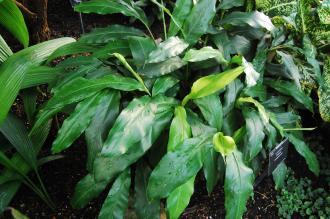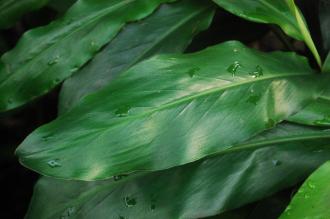
Elettaria cardamomum (16/01/2016, Kew Gardens, London)
Position: Indirect bright
Flowering period: All year round
Soil: Moist, well drained
Eventual Height: 4m (in the wild)
Eventual Spread: 2m (in the wild)
Hardiness: 10b, 11, 12, 13
Family: Zingiberaceae
Elettaria cardamomum is an evergreen aromatic tropical herbaceous perennial with a clump forming habit. Its dark leaves are linear to lanceolate with entire margins, up to 60cm long and 10cm across. Its white and violet flowers are produce on lose spikes which are up to 60cm long. Its yellow/ green fruit is a pod and up to 2cm long. Its roots contain fleshy rhizomes which aids its slow spread.
Elettaria cardamomum, commonly known as Cardamom, Green Cardamom or True Cardamom, is native to south India. In its native habitat it grows as a tropical woodland understory plant.
The etymological root of the binomial name Elettaria is from the Indian/ Hindi vanacular name for this plant ‘Elattari’. Cardamomum is derived from the ancient Greek name for the seed of this plant.
The landscape architect may find Elettaria cardamomum useful as an unusual foliage plant suitable for planting in warm, humid locations e.g. a bathroom. It may be necessary to grow this plant from seed as it is not currently readily available.

Elettaria cardamomum Leaf (16/01/2016, Kew Gardens, London)
Ecologically, Elettaria cardamomum flowers are attractive to pollinating insects.
Elettaria cardamomum prefers moist, fertile, well-drained soils. It tolerates most pH of soil.
When maintaining Elettaria cardamomum as a houseplant its soil should be watered regularly. Its preferred active growing temperature rages from between 22ºc to 32ºc, although it will tolerate 16ºc as long as its soil is not too moist. Feeding with weak fertiliser solution should be carried out once a month during the growing season.

Landscape Architecture

